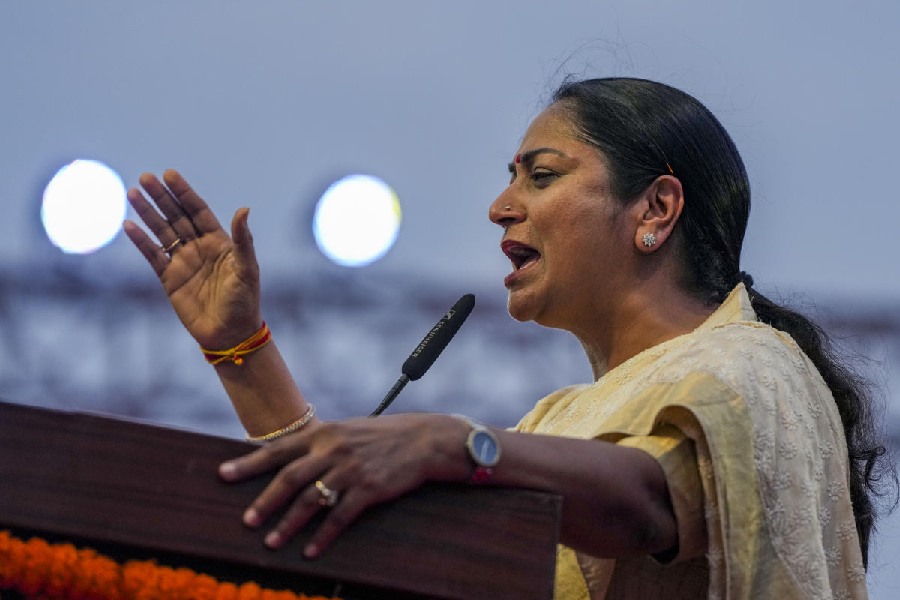 |
| COURTESY OF SIMON RAY, LONDON |
There is a story from Abu’ Fazal’s Akbarnama which describes the return of Mughal Emperor Humayun to Kabul in 1545. Following his defeat at the hands of Sher Shah Suri in 1540, Humayun had been forced to leave India, and along with his wife, Hamida Begum, had gone to seek the support of Shah Tahmasp of Iran. Their son, the one-year-old Akbar, had been left behind in Kabul.
Two years later Humayun — now supported by the Shah’s armies — approached Qandahar and eventually captured Kabul without a fight. He triumphantly entered the fort and was re-united with Akbar, now three years old.
He then decided to test his young son. He had all the ladies enter the fort dressed the same way, with the Queen indistinguishable from the rest. Akbar, who had last seen his mother when he was only a year old, recognised her instantly and climbed into her arms. Humayun was amazed and convinced that Akbar had supernatural powers. The story depicting this scene is faithfully recreated by court painter Madhu for the pages of the Akbarnama. It is one of the stunning miniature paintings on display at Mughal India: Art, Culture and Empire, a new exhibition at the British Library.
The exhibition showcases the British Library’s breathtaking collection of manuscripts and paintings along with objects on loan from private collections from the four centuries spanning the Mughal period — from Babur in the 16th century to Bahadur Shah Zafar II in the 19th.
Among the stunning exhibits are one of the last four surviving copies of Baburnama made for Akbar and the text of the Hamzanama (The Story of Amir Hamza, the uncle of the Prophet), the exquisitely illustrated manuscript of the Khamsa or the “five poems” of Nizami Ganjavi, a 12th century Persian poet, the Gulistan, a collection of moralising stories written by the Persian poet Sa’di, and the collected poems of Hafiz. It also has detailed ministerial and land records, books of poetry and instruction and religious and scientific texts.
 |
“The exhibition will give visitors a fascinating overview of a relatively little-known dynasty, displaying newly discovered royal portraits and manuscripts, as well as iconic artwork,” says Malini Roy, curator of the exhibition. Roy, who is curator of the visual arts at the British Library has also co-authored the book Mughal India, Art, Culture and Empire with eminent former British Library curator, J.P. Losty, for the exhibition.
“Most exhibitions and books on the Mughals focus on the first six rulers till Aurangzeb, as that is seen as the height of Mughal power,” says Roy. “I wanted to look at the rise and fall of the Mughal empire and to use our collection at the British Library to do so, “ she adds.
Divided into eight broad sections, the exhibition covers the foundation of the Mughal Empire, the Emperors, Life in Mughal India, the Art of Painting, Religion, Literature, Science and Medicine and finally the Decline of the Empire.
A centrepiece of the exhibition is the Panorama of Delhi, a five-metre long painting by Mazhar Ali Khan (1846). It is drawn from the viewpoint of the southern tower of the Lahore Gate of the Red Fort and is a 360 degree overview of the Mughal city and palace complex along with the local area, including the Jama Masjid and Chandni Chowk.
That’s not all. Viewers can see the journal of Sir Thomas Roe, ambassador to the court of Jahangir in 1616, copied neatly by his secretary Edward Heynes, recording his first meeting with Jahangir in Ajmer. The diary gives a vivid account of life at court, Roe describing Jahangir as “very merrie and joyful”. There is also a letter from King William III to Aurangzeb signed “your loving friend, William” to which Aurangzeb sends a characteristically cold and formal reply.
The golden years of the Mughal rule — under Akbar, Jahangir and Shah Jehan — saw the flourishing of art and literature. One of the most charming books in the collection is Bayaz-i-Khuusbhu (Notebook of Fragrance, 1698). Over 17 chapters the unknown author discusses recipes for perfumes and soaps, meals and drinks, arranging a house and garden, and even how to fit a library.
 |
| High art: (From top) A jade gem-set flywhisk handle; an illustration from Akbarnama; an ivory model showing Akbar II listening to musicians |
Shah Jehan’s recipe book — Nuskhah-y i-Shah Jahani — containing recipes for pulao, kebabs, fish, samosas and sweets is also part of the exhibition, as is a book on the art of pigeon raising, Kabutarnama, by Valih Musavi (1788). There is also a Guide to Archery — Hidayat al-rami by Muhammed Budeh (1722). It is a treatise on archery, complete with illustrations. In one section it describes five different ways of stringing a bow — one for use when mounted on horseback, two while standing and two while seated.
Akbar’s secularism was well known, as was his creation of the new religion Din-i-Ilahi. The exhibition has the rare manuscript of the translation of the Mahabharata commissioned in Persian by Akbar. Called the Razmnama — the Book of Battles — the translation was ordered in 1582. The literal Persian version was then turned into elegant prose by the poet Faizi, the brother of Abu’ Fazal.
In contrast to the secularism of earlier Mughals, the reign of Aurangzeb saw the imposition of a strict Islamic code. The manuscript of the Al Fatwa al Alamgiriya is a stark work commissioned by Aurangzeb to record Islamic jurisprudence in Arabic.
The Mughals were great collectors of books too. During Akbar’s time, the Imperial Library consisted of over 24,000 volumes. Humayun’s wife, Hamida Banu Begum (1527-1604) was one of the few Mughal women to have a library of her own. Princess Jahanara, Shah Jahan’s daughter, wrote the biography of Muin-ud-din Chisti, the Sufi saint.
The last section of the exhibition covers the decline of the Mughals after Aurangzeb. The black and white photograph of the old and frail Bahadur Shah Zafar II lying in captivity in the Red Fort, the first photograph of a Mughal Emperor, brings out the stark end of the Mughal period. Jivan Lal, a munshi at Bahadur Shah’s court, who kept a daily diary during the Mutiny, records a telling moment on 11 May 1857:
“On the morning of the 11th of May between eight and nine ’clock, a strange report reached me as it spread through the city, that some cavalry and foot soldiers had arrived from Meerut and were in the bazaar plundering and killing the people.”
The era of the Mughal dynasty was to end very soon after that.











